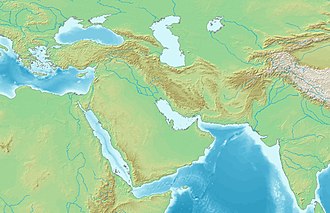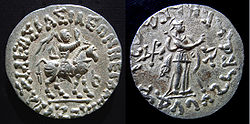The plaques
The plaques are thought to have been decorative belt buckles. They are decorated with battle scenes between soldiers armed as cataphracts, and one hunting scene. There are three other plaques, smaller in size, on which are depicted a vulture, fighting Bactrian camels, and warriors. [1] [3] The date and attribution of the plaques are disputed, although the consensus tends to suggest a 1st-century CE date.
The plaque with the battle scene depicts a clash with armored warriors. There are soldiers battling on foot, and before them there is a horseman brandishing a sword clashing with another horseman relying on his lance. A warrior has been deprived of his horse down to the right. His lance is broken and he prepares, with his sword, to fight his opponent, a horseman lunging on him with a lance. [3] [1] [4] According to Markus Mode, the composition was originally larger, and it was copied from another source. [1]
One hypothesis is that the plaque depicts a battle between the sedentary Sogdians and the nomadic invaders. In it, the Sogdian hero, leader of his group, repels the attacks of the groups of nomads. For the Sogdians the nomadic incursions were a real threat. According to Mode there is more to it than the record of a battle. The plaque is "a very early manifestation of the narrative imagery that characterizes Sogdian art—one that finds its supreme expression in the painted cycles of 7th- and early 8th-century Panjikent." [1] Thus, the purpose of Sogdian art was to transmit narrative. In their paintings and carvings, "Sogdian artists would include only the essentials. Lines, blocks of color, and a few landscape elements to set the scene create an easy-to-read two-dimensionality that helps advance the progress of the depicted tale." As noted by Mode, this style's origin may be seen in two Orlat plaques. [3] [1]
Yuly Khudyakov found numerous similarities between the plaques and other Xiongnu-Sarmatian finds from Mongolia and Altay, particularly a group of plaques retrieved from Tepsei Mount near the Yenisey River, usually attributed to Tashtyk culture.
Pugachenkova believes the plaques were made by the inhabitants of Kangju, thought to have been closely related to the Kushans and Tocharians. The Kangjus were probably Scythians, opposed to the Kushans, as seen in Khalchayan. [5] Overall, the soldiers would be either Sogdians or Sakas, [6] much less probably Yuezhis or Parthians.
Full drawing of one of the Orlat plaques.
Orlat plaque horserider.
Detail of one of the Orlat plaques.
[7] A severed head is probably hanging in front of the horse.
[8] Orlat archer (detail of the plaque).
Orlat axeman (detail of the plaque).
Orlat plaque encounter.
Orlat plaque encounter.
Orlat plaque hunter.
This page is based on this
Wikipedia article Text is available under the
CC BY-SA 4.0 license; additional terms may apply.
Images, videos and audio are available under their respective licenses.














